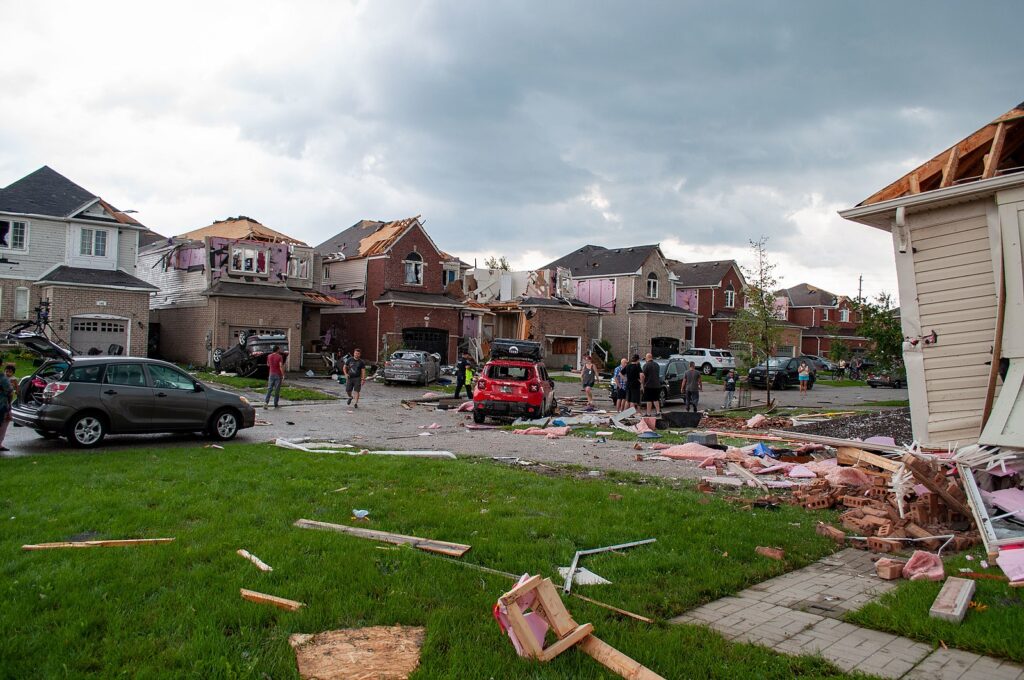
Opinion: We have to get off the disaster hamster wheel
November 24, 2022
By Glenn McGillivray and Keith Porter
 A tornado ripped through Barrie, Ont., in July 2021. (Duckdave/Wikimedia), CC BY-SA.
A tornado ripped through Barrie, Ont., in July 2021. (Duckdave/Wikimedia), CC BY-SA. Canada is an interesting case in that those who are involved in the many facets of disasters (like first responders, governments, insurers, disaster restoration contractors, academics and others) are seeing the environment change before their very eyes. Countries like the United States have experienced regular large, impactful disasters since forever, but this hasn’t been the case here. Sure, we got our share of smaller events, but these tended to be spread out over the course of many (often many many) months. This made it quite easy to deal with them, as they tended not to tax any one entity’s resources. We could apply whatever people power, financial resources and expertise needed to recover, then get a break before the next one.
The only real exception was the Eastern Canada Ice Storm, the country’s first billion dollar insured loss event. Prior to this storm in the opening days of 1998, the country never experienced a loss of this magnitude – not even close. What’s more, that loss loomed large for 15 years until the damage was surpassed by the Southern Alberta floods in June 2013. From the standpoint of probability, the ice storm was considered an “outlier” – a statistical oddball.
But things aren’t playing out this way anymore, as loss events are starting to pile up like cordwood, placing immense pressure on those whose job it is to respond.
Losses from floods, severe winds, wildfires, and other perils are currently costing Canada about $6 billion annually; about $2.2 billion is insured while the rest is uninsured. That’s two per cent of the value of construction put in place annually, equivalent to eight days of nationwide construction.
To put it another way, Canadian catastrophe losses are growing nine per cent annually, three times faster than GDP, six times new construction, and 10 times faster than the population.
We are seeing significant disasters occurring in (at least) two places simultaneously, like the bookended atmospheric rivers on both the west and east coasts in November 2021 that necessitated the deployment of Canadian Armed Forces personnel in both places at once.
We are seeing significant disasters occurring within short intervals of each other, like the heat wave, wildfires and atmospheric river event that came in quick succession in B.C. last year, or the June 2013 Southern Alberta floods that were followed by the July 8, 2013 Toronto flood three weeks later (Canada’s first-ever back-to-back billion dollar loss events).
And we are hearing reports of the same Canadian households getting hit by more than one disaster in short order. For example, many households hit by the July 2013 flooding in Toronto were also hit by the Southern Ontario ice storm in December of that year. Many households that were evacuated in B.C. in summer 2021 due to the active wildfire season (the third worst season for area-burned in the province’s history) were also impacted by the atmospheric river flooding just a couple of months later. And if they weren’t directly affected, they were indirectly impacted by cut-off roads, broken supply chains and the gas rationing that had to take place as a result.
All of this should worry us.
Ordinary Canadians pay for these mounting losses in one way or another. Insurers pay the insured part, but that money ultimately comes from customer premiums. The rest comes from homeowners, tenants, businesses, and the taxes they pay.
As losses grow faster than the population, new construction, and GDP, they eat up a larger and larger share of the value that otherwise feeds, houses, and improves our lives, until we begin to spend as much (or more) recovering from disasters as we do building for the future.
The trend is also worrisome because it says that, as we build, we create new risk rather than reduce it. New buildings ought to be more resilient than older ones so as we build new buildings and replace old ones, per capita losses should decrease. But that’s not happening.
Something is wrong with what we are building, how we are building and where we are building. Climate change is partly to blame, but we should be designing for that – but we aren’t.
We need to understand what we are doing wrong with new construction if we want to stop paying for ever-larger catastrophes. Only by doing so can we hope to navigate costly decisions about how to do better and how to fairly share the cost.
Glenn McGillivray is managing director of the Institute for Catastrophic Loss Reduction and adjunct professor of disaster and emergency management at York University.
Keith Porter, PE, PhD is chief engineer of the Institute for Catastrophic Loss Reduction and adjunct professor of engineering at Western University.
Print this page